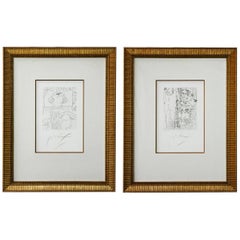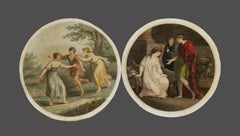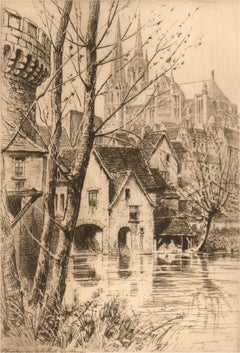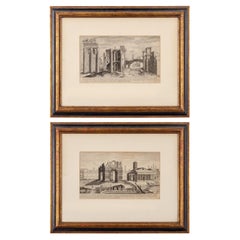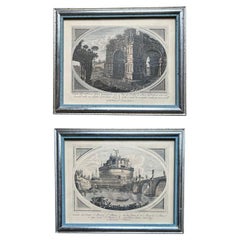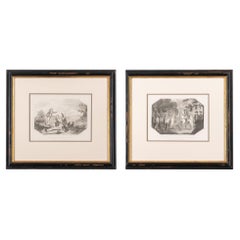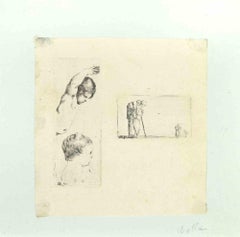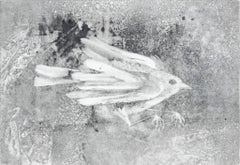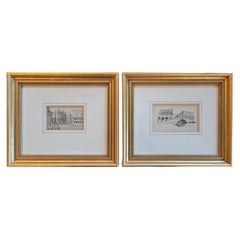Pair Of Etchings
to
20
167
30
83
80
49
25
25
22
19
15
12
7
7
6
6
6
6
5
4
4
3
3
3
3
2
2
2
2
1
1
1
1
1
1
1
6
2
2
2
2
Sort By
Pair of Etchings by Peter Max V3 X and XI
By Peter Max
Located in Rio Vista, CA
Fantastic pair of rare framed etchings by Peter Max (American b. 1937) V3 X and XI. In the manner
Category
20th Century American Mid-Century Modern Drawings
Materials
Linen, Plexiglass, Giltwood, Paper
$4,000 Sale Price / set
20% Off
Pair of Genre Scenes - Etching after Angelika Kaufmann - 1780s
Located in Roma, IT
Pair of Genre Scenes is a pair of etching realized by Angelika Kaufmann in 1780s.
The circular
Category
Late 18th Century Figurative Prints
Materials
Etching
Charles Pinet (1867-1932) - Pair of Late 19th Century Etching, French Towns
Located in Corsham, GB
A charming pair of etchings of a French town scenes overlooking the cathedral. The artist has
Category
Late 19th Century Landscape Prints
Materials
Etching
Étienne Dupérac Etchings of Ancient Roman Ruins, 17th Century - A Pair
Located in Savannah, GA
Étienne Dupérac
(French, 1535-1604)
A pair of etchings from I vestigi dell'antichita di Roma
Category
Antique 17th Century Italian Classical Roman Prints
Materials
Paper
Italian Framed Lithograph Prints or Etchings - A Pair by Borghese
By Borghese
Located in Oklahoma City, OK
A pair of etchings or lithograph prints by Giovanni Battista Piranesi and Domenico Baldini. Each
Category
Mid-20th Century Italian Rococo Revival Prints
Materials
Metal
$300 Sale Price / set
25% Off
Pair of English Etchings and Engravings by William Grainger '1802-04'
Located in Kenilworth, IL
Pair of etchings and engravings on laid paper by William Grainger (1765–1809), after William
Category
Antique Early 1800s English Prints
Materials
Paper
$455 Sale Price / set
30% Off
Two Studies of Children;A Mom... - Etching by Stefano Della Bella - 17th Century
By Stefano Della Bella
Located in Roma, IT
This pair of etchings, executed on a single sheet, was realized by Stefano Della Bella in 17th
Category
17th Century Old Masters Figurative Prints
Materials
Etching
Bird In The Rain, #1 and #2
By Kelly Fearing
Located in Austin, TX
A Pair of Etchings by Kelly Fearing, done in 1982. The price is for the pair.
Kelly Fearing
Category
1980s Animal Prints
Materials
Archival Paper, Etching
Pair of Venice Etchings by N Erichsen 1904
Located in Dallas, TX
Presenting a lovely pair of Venice etchings by N Erichsen 1904.
This pair of etchings were drawn
Category
Early 20th Century Italian Edwardian Prints
Materials
Paper
$1,200 / set
Scarabei Tropicali - Etching by Luigi Bartolini - 1930
By Luigi Bartolini
Located in Roma, IT
artwork realized by the great Italian engraver and poet Luigi Bartolini in 1930.
Very rare pair of
Category
1930s Figurative Prints
Materials
Etching
"Westminster Abbey, " complete portfolio of 13 etchings by John Sloan
By John Sloan
Located in Milwaukee, WI
pair of etchings are custom framed. Each have hand-laid silk mats with recessed bevels, Museum Glass
Category
1890s Ashcan School Interior Prints
Materials
Paper, Etching
Pair of Brass Etchings
Located in New York, NY
Pair of circa 1950s English Montgolfier etchings with wood frames.
Measurements:
Height: 18.75
Category
Vintage 1950s English Decorative Art
Materials
Brass
$3,200 / set
Antique Pair Etchings of Horses
By Jan Frans Van den Hecke
Located in Alessandria, Piemonte
Pair of antique etchings from the 17th Century by Johannes Van Den Hecke (1620-1670): he was a
Category
Antique Mid-17th Century Dutch Other Prints
Materials
Paper
$2,153 / set
Pair of Framed English Etchings
Located in New York, NY
A pair of circa 1930's English prints with gilt frames.
Measurements:
Height: 9.5"
Width: 7.5
Category
Vintage 1930s English Prints
Materials
Giltwood, Paper
$450 / set
A pair of JAMES COIGNARD Carborundum Etchings
Located in Long Island City, NY
A pair of JAMES COIGNARD (1925- 2008). Carborundum Etchings., France .. Each signed and numbered by
Category
Late 20th Century French Scandinavian Modern Prints
Materials
Paper
$3,000 / set
Pair of 19th-Century Neoclassical Etchings by Giovanni Battista Piranesi
By Giovanni Battista Piranesi
Located in Denver, CO
Enhance your collection with this exquisite pair of 19th-century Neoclassical black and white
Category
19th Century Neo-Expressionist Still-life Prints
Materials
Etching
Dan Flavin, For a pair of curvilinear walls - Signed Etching, Minimalism
By Dan Flavin
Located in Hamburg, DE
Dan Flavin (American, 1933-1996)
For a pair of curvilinear walls placed to reflect circular
Category
20th Century Minimalist Abstract Prints
Materials
Drypoint, Etching
Pair of Compositions - Etching by N. Gattamelata - Late 20th Century
By Nazareno Gattamenata
Located in Roma, IT
Pair of Composition are a black and white couple of etchings realized by Nazareno Gattamelata in
Category
Late 20th Century Modern Figurative Prints
Materials
Etching
A Pair of Abstract Aquatint Etchings by Sydney Drum 1980
Located in Long Island City, NY
Artist: Sydney Drum, Canadian (1962 - )
Title: Set of Two Etchings
Year: 1980
Medium: Etching with
Category
1980s Abstract Abstract Prints
Materials
Etching, Aquatint
Modern Pair of Oriental Numbered and Signed Etching
Located in Roma, IT
1970s Pair of black and white important numbered and signed etching.
Japan 1973.
Every item of our
Category
1970s Modern More Prints
Materials
Paper, Lithograph
Large Pair of Aquatint Etchings 1982 Ed Moses
By Ed Moses
Located in Los Angeles, CA
abstract techniques.
Aquatint etching on arches paper.
Artist signed in pencil with Low editions #5 of #12
Category
Late 20th Century American Modern Prints
Materials
Paint, Paper
$4,000 / set
THE BURRO STATION - Large Etching with Incredible Detail. One of a Pair
By Reynold Weidenaar
Located in Santa Monica, CA
REYNOLD WEIDENAAR (1915 - 1985)
THE BURRO STATION, 1946, Etching and drypoint on paper, Signed and
Category
1940s American Realist Figurative Prints
Materials
Etching
Antique Pair of English Maritime Colored Etchings 1806.
Located in Vero Beach, FL
Antique Pair of English Maritime Colored Etchings 1806.
English hand-colored etchings of a 90 Gun
Category
Antique 19th Century English Romantic Nautical Objects
Materials
Glass, Giltwood, Paper
$640 Sale Price / set
20% Off
Pair of Female Nude Etchings by Sergei Firer
By Sergei Firer
Located in New York, NY
Sergei Firer (Russian, b. 1954).
Reflect II and III etchings.
Both pencil numbered 82/90 LL
Category
Late 20th Century Canadian Drawings
$1,450 / set
Pair of Ettore Fagiuoli framed signed etchings of Venice and Verona
Located in Atlanta, GA
A pair of signed etchings dated 1926 by Italian artist Ettore Fagiuoli. Beautifully matted in off
Category
Vintage 1920s Italian International Style Drawings
Materials
Paper
TEN O'CLOCK in TAXCO - Large etching with Incredible Detail. One of a Pair
By Reynold Weidenaar
Located in Santa Monica, CA
13"; Sheet: 19.75" x 15.75”. One of a pair of large format Mexican etchings with incredible detail by
Category
1940s American Realist Figurative Prints
Materials
Etching
Pair of Gilt Bronze Candle Holders with Etching Design
Located in Los Angeles, CA
Pair of Gilt Bronze candlesticks.
The pair are very tall, at 19.5" - the top is a square plate (4
Category
20th Century Art Deco Candelabras
Materials
Gold, Bronze, Gold Leaf
$880 Sale Price / set
20% Off
Beautiful Pair of Colored Etchings with Royal Shield Motife
Located in Hopewell, NJ
Beautifully framed pair of colored etchings having a regal feel with royal shields flanked by lions
Category
Vintage 1970s American Prints
Materials
Paper
$1,440 Sale Price / set
20% Off
Pair of Vintage Blue Glass Urns With Greek Key Etching
Located in Charlottesville, VA
Vibrant blue glass urns featuring etched Greek key bands and clear stepped bases. The geometric design is crisply defined across each piece, and a close view reveals fine detail in t...
Category
21st Century and Contemporary American Urns
Materials
Glass
Pair of contemporary Venice views. Prints by F. Galli, Italian etcher.
By Federica Galli
Located in Milan, IT
Here we propose a pair of etchings by Federica Galli, whose size, subjects and composition form a
Category
20th Century Contemporary Landscape Prints
Materials
Etching
Pair of Vintage Original Etching Le Tricorne 1958 Signed Print by Salvador Dali
Located in Los Angeles, CA
Pair of Vintage Original Etching Limited Edition " La Tricorne" 1958 Signed Print by Salvador Dali
Category
Vintage 1950s Spanish Decorative Art
Materials
Wire, Gold Leaf
Pair 18th Century Framed Italian Etchings of Churches in Rome by Guiseppe Vasi
Located in Stamford, CT
Pair of 18th century Italian architectural etchings of churches in Rome by Guiseppe Vasi (1710-1782
Category
Antique Mid-18th Century Italian Neoclassical Prints
Materials
Paper
Poems of W.B. Yeats (with 6 Etchings by Richard Diebenkorn, ~21% OFF)
By Richard Diebenkorn
Located in Kansas City, MO
with red titles and black Baskerville monotype, are paired with six of Diebenkorn's figurative etchings
Category
1990s Modern Prints and Multiples
Materials
Etching
$2,999 Sale Price
21% Off
Antique Japanese Asian Women Portrait Etching Print Signed, a Pair
Located in Plainview, NY
A pair of antique colored etching prints each depicting a Japanese woman. One woman is wearing the
Category
Late 19th Century Portrait Prints
Materials
Glass, Paper
$1,350 Sale Price
46% Off
Emile Buland (1857-1938) Two romantic engravings of women after Antoine Calbet
Located in Argenteuil, IDF
Rare and beautiful pair of etchings on BFK Rives watermarked vellum paper, signed, titled, and
Category
Early 20th Century French Romantic Prints
Materials
Paper
Pair of Hand-colored Romantic French Engravings after Francois Boucher
By (After) Francois Boucher
Located in Alamo, CA
A pair of French classical romantic prints original created in the 18th century by Jacques-Firmin
Category
18th Century Romantic Figurative Prints
Materials
Engraving, Etching
Views of London: A Pair of Framed 19th Century Engravings by Havell and Allom
Located in Alamo, CA
This is a pair of framed hand-colored prints, both utilizing engraving and etching techniques
Category
Mid-19th Century Naturalistic Landscape Prints
Materials
Engraving, Etching
Pair of Etched Dogu-Style Terracotta Figures
Located in Chicago, IL
etchings. This pair of ceramic figurines closely resemble these ancient forms, featuring short, bulbous
Category
Antique 15th Century and Earlier Unknown Pre-Columbian Figurative Sculpt...
Materials
Ceramic
$1,980 / set
Antique Danish Søren Lund (1852-1933) etchings with St. St. Blicher qoutes
Located in Ebberup, DK
This is a pair of antique etchings by renowned Danish artist Søren Lund.
The etchings have motives
Category
Early 20th Century Danish Art Deco Paintings
Materials
Composition
Vicke Lindstrand for Kosta Boda Swedish Modernist Pair of Etched Glass Vases
By Vicke Lindstrand
Located in Palm Springs, CA
A pair of clear glass vases with etching of bamboo sprigs created by Vicke Lindstrand for Kosta
Category
Vintage 1970s Swedish Mid-Century Modern Vases
Materials
Art Glass
Poems of W.B. Yeats.
By Richard Diebenkorn
Located in New York, NY
with red titles and black Baskerville monotype, are paired with six of Diebenkorn's figurative etchings
Category
1990s More Art
Materials
Paper
Lilypad Swans
By Francois Soulas
Located in Houston, TX
Elegant etching of pair of swans by French artist Francois Soulas, 1969. Signed in pencil lower
Category
1960s Animal Prints
Materials
Etching
Genre Scenes Compositions - Original Artwork after Angelika Kauffmann - 1780
Located in Roma, IT
artwork consist in a pair of mixed colored hand watercolor etchings realized from two original painting of
Category
Late 18th Century Modern Figurative Prints
Materials
Paper, Etching, Watercolor
Pair of Etchings V. 3. IX and XII
By Peter Max
Located in Rio Vista, CA
Fantastic pair of Peter Max (American b. 1937) V. 3. IX and XII. In the manner of Picasso each
Category
Late 20th Century Surrealist Figurative Drawings and Watercolors
Materials
Paper, Pencil, Color Pencil
"Two Women" Pair Etchings
By Marie Laurencin
Located in Rio Vista, CA
Elegant pair of etchings by Marie Laurencin (French 1883-1956) from the "Poemes de Sapho" published
Category
20th Century Modern Portrait Prints
Materials
Etching
Pair Bob Wygant Etchings Rustic Cabins
Located in Seguin, TX
Pair of etchings on cream heavy paper by Bob Wygant (1927-2008) Texas. Signed, titled Sharcropper's
Category
Late 20th Century American Rustic Prints
Materials
Paper
Pair Bob Wygant Etchings Log House & Depot
Located in Seguin, TX
Pair of etchings, log cabin and Kirbyville Train Depot on cream heavy paper by Bob Wygant (1927
Category
Late 20th Century American Rustic Prints
Materials
Paper
Pair of Egyptian Etchings
Located in Northfield, IL
Beautifully Framed Egyptian Etchings
Category
Antique 19th Century Egyptian Prints
$995 / set
Pair of Golf Motif Colored Etchings
Located in West Palm Beach, FL
Golf motif colored etchings by Martha Hinson 1936-20130, a pair.
Note: Pencil signed, titled and
Category
Late 20th Century American Modern Prints
Materials
Paper, Glass, Wood
$850 / set
Pair Of Military Etchings, Officers On Horseback.1805.
Located in Alicante, ES
Published by William Miller, Albermarle St. Jan `y 1st. 1805.A fine quality pair of red mounted
Category
Antique 19th Century Prints
An Ethereal Hand Painted Etching of a Pair of Angels
Located in San Francisco, CA
Against a black background; depicting two views of the goddess Nike attired in Grecian style robes; one wearing lavender carrying a cornucopia representing abundance; the other in oc...
Category
Antique 19th Century French Prints
Materials
Paper
Pair of Large 18th Century French Military Campaign Etchings
By Louis-Nicolas Van Blarenberghe
Located in Southampton, NY
Pair of large 18th century, French military Campaign etchings. They each have a floral bordered
Category
Antique Mid-18th Century French Prints
Materials
Glass, Paper, Pine
Pair of Lucas Vorsterman Colored Etching "the art of riding a horse"
Located in Lentate sul Seveso (Mb), IT
Pair of Lucas Vorsterman (Anversa 1624-1677) colored etching belonging to the work "the art of
Category
Antique 17th Century Dutch Baroque Prints
Materials
Paper
Pair of 2 prints - Drink for Men & Drink for Woman
By Roman Romanyshyn
Located in Van Nuys, CA
Wo separate prints. Drink for men is the image of a woman on a drinking stein with blind embossed handle. Drink for Woman is the image of a man on a drinking stein. The images are v...
Category
Early 2000s Contemporary Figurative Prints
Materials
Mezzotint, Etching, Aquatint
Pair of 3 Colored etches “Journal des dames & des demoiselles” Paris France 1870
Located in Antwerpen, BE
This pair of three detailed colored etchings, dating from 1870, offer a fascinating insight into
Category
Antique 19th Century French Art Nouveau Drawings
Materials
Paper
Legendary Roses
By Pierre-Joseph Redouté
Located in New York, NY
The Perfect Gift - A Pair of glorious etching restrikes of watercolors titled "Rosa Bifera
Category
1950s Realist Still-life Prints
Materials
Etching
Two Charming Thatched Cottages
By Beruard
Located in New York, NY
A pair of hand-signed original color etchings of thatched cottages in the French countryside
Category
1950s Realist Landscape Prints
Materials
Etching
- 1
Get Updated with New Arrivals
Save "Pair Of Etchings", and we’ll notify you when there are new listings in this category.
Pair Of Etchings For Sale on 1stDibs
There is a range of pair of etchings for sale on 1stDibs. Frequently made of glass, brass and metal, all pair of etchings available were constructed with great care. Pair of etchings have been produced for many years, with earlier versions available from the 18th Century and newer variations made as recently as the 21st Century. Victorian, Regency and Modern pair of etchings are consistently popular styles. Giovanni Battista Piranesi, Abraham Bloemaert and Andrea Scacciati each produced beautiful pair of etchings that are worth considering.
How Much are Pair Of Etchings?
The average selling price for at 1stDibs is $2,400, while they’re typically $200 on the low end and $12,000 highest priced.
Questions About Pair Of Etchings
- What is etching?1 Answer1stDibs ExpertSeptember 25, 2019
Etching is a method of making prints using metal plates onto which a design has been incised by acid.
- What is a Picasso etching?1 Answer1stDibs ExpertApril 5, 2022An etching is created by cutting down a metal plate with chemicals, including acid, to achieve the desired image. The metal plate is then inked and pressed onto a piece of paper. Picasso became fascinated with etchings when he moved to Paris in the early 1900s, and would go on to pioneer new techniques with etchings throughout his career. Shop a selection of Pablo Picasso pieces from some of the world’s top art dealers on 1stDibs.
- What are the types of etching?1 Answer1stDibs ExpertSeptember 25, 2019
There is dry and wet etching.
- How do you identify an etching?1 Answer1stDibs ExpertNovember 26, 2024To identify an etching, look in the corners and on the back for an artist's signature or publisher information. Cross-referencing markings with information shared on trusted online resources can allow you to determine the artist. From there, you can browse online and print catalogues of their work to find out the title and date of the etching. In terms of how to tell an etching apart from other types of prints, one telltale sign is the appearance of slightly blurry lines along the edges. Called plate marks, these lines form from the pressure exerted by the plate during the etching process. You may need a magnifying glass to spot the plate mark on a print. If you have any difficulty with the identification process, consider enlisting the help of a certified appraiser or experienced art dealer. Shop a collection of etchings on 1stDibs.
- What is etched glass?1 Answer1stDibs ExpertFebruary 22, 2021Etched glass is a type of decorative glass which is the result of small cuts made to the glass. The cuts, which appear white, typically form patterns or images.
- What is vintage etching?1 Answer1stDibs ExpertApril 5, 2022Vintage etching is a term that refers to a specific type of print produced between 50 and 100 years ago. Printmakers produced etchings by carving images into a copper plate and then soaking it in an acid bath. Then, they applied ink to the plate and pressed it against paper or another material to create an image. On 1stDibs, find a collection of vintage etchings.
- What is an original etching?1 Answer1stDibs ExpertMarch 13, 2024An original etching is a print produced during the first production run of a print series. After making an etching plate, an artist will create a limited number of etchings. Collectively, these prints are the original etchings. They differ from restrike etchings made years later, sometimes after the death of the artist. On 1stDibs, shop a diverse assortment of etchings.
- 1stDibs ExpertOctober 24, 2024To tell a lithograph from an etching, look closely along the edges of the print. Etching is a way of incising lines on a metal plate by first drawing on an acid-resistant coating, or ground, to reveal the metal beneath. Lithography uses a stone rather than a plate. As a result, etchings will usually have a faint imprint or indentation called a plate mark, while a lithograph will not. Researching the artist using trusted online resources may also be helpful, as some printmakers worked exclusively with etchings or lithographs. Find a large selection of lithographs and etchings on 1stDibs.
- Did Picasso make etchings?1 Answer1stDibs ExpertApril 5, 2022Yes, Pablo Picasso made etchings and took that foundation into an exploration of printmaking and the different methods of that medium. Picasso first began working on etchings in the early 1900s, quickly mastering the technique, and then he began expanding and pushing the boundaries to create a unique and signature style. On 1stDibs, find a variety of original artwork from top artists.
- Can I etch the back of a mirror?1 Answer1stDibs ExpertApril 5, 2022Yes, you can etch on the back of a mirror. Modern mirrors typically have a reflective layer that is deposited on the back of the glass. If you want to etch the back of a mirror you need to remove the reflective layer, which can be done with an engraving tool or with an etching solution. Shop a range of antique and modern mirrors on 1stDibs.
- 1stDibs ExpertAugust 26, 2024The difference between an etching and a print depends on how specific the terms are. Print is a general term for any type of artwork made by transferring an image onto another material, such as paper or fabric. A specific printmaking technique, etching is a way of incising lines in a metal plate by first drawing on an acid-resistant coating, or ground, to reveal the metal beneath. The plate is then submerged in acid, which “bites” the lines into the metal plate. On 1stDibs, find a large selection of etchings and other prints.
- 1stDibs ExpertOctober 15, 2024To tell if an etching is valuable, one approach is to conduct research using trusted online resources. The maker, age, image quality, historical significance and overall condition all play a role in determining the potential value of an etching. By seeing how much similar etchings have sold for in the past, you can get a rough idea of how much your piece may be worth. However, experts generally recommend having a certified appraiser or experienced art dealer evaluate prints for a more accurate valuation. Find a wide range of etchings on 1stDibs.
- 1stDibs ExpertAugust 26, 2024The difference between etching and aquatint is technique. Invented in the 1500s, etching is a way of incising lines in a metal plate by first drawing on an acid-resistant coating, or ground, to reveal the metal beneath. The plate is then submerged in acid, which “bites” the lines into the metal plate. The ground is then removed, and the plate is inked for pressing. Etched lines tend to reveal the movement of the artist’s hand more than a technique like engraving, since the image is created on softer ground. Aquatint, a technique named for its resemblance to watercolor or ink wash, is often combined with etching to create rich tonal variations. It’s a similar process to etching, but the resin ground is more granulated, so the acid handles the metal differently. Different degrees of darkness are created based on the amount of time the plate is in contact with the acid. Find a collection of etchings and aquatint prints on 1stDibs.
- 1stDibs ExpertApril 3, 2024The difference between a lithograph and an etching is that while both are types of prints, they are made using different techniques. With respect to lithography, the image to be printed is drawn or painted on a stone or metal plate with an oil-based substance, such as a greasy crayon or tusche (an oily wash). The stone is then covered with water, which is repelled by the oily areas. Oil-based ink is then applied to the wet stone, adhering only to the oily image. Afterward, the stone is covered with a sheet of paper and run through a press.
Etching is a way of incising lines in a metal plate by first drawing on an acid-resistant coating, or ground, to reveal the metal beneath. The plate is then submerged in acid, which “bites” the lines into the metal plate. The ground is then removed and the plate is inked for pressing.
Find a collection of lithographs for sale on 1stDibs. - 1stDibs ExpertMarch 22, 2022Rembrandt's etchings are important because of the influence they had on printmaking. The printing techniques that he employed allowed each of his prints to seem very unique while making it possible for him to mass produce his images. Printmakers that followed utilized the advancements he made in the field to create and distribute their own prints. Find a range of Rembrandt art on 1stDibs.
- 1stDibs ExpertAugust 29, 2024To tell if an etching is original, first gently run your hand along its surface. An original etching will usually have a slight indentation in the image area left behind by the pressure applied by the plate during the printing process. Next, grab a magnifying glass and view the image up close. On an original, you won't see small dots making up the picture, but many reproductions do display dots due to their printing methods. Finally, look at the signature. Most original etchings will be hand-signed. If the signature is printed on your piece, it may be a reproduction. Consult a certified appraiser or experienced art dealer for an expert opinion on your print. Find a wide variety of etchings on 1stDibs.
- 1stDibs ExpertOctober 30, 2024Yes, some original etchings are worth something. Original signed prints by Old Masters like Rembrandt and Albrecht Dürer are particularly valuable, as are those made by modern artists such as Paul Klee, Henri Matisse, Martin Lewis and David Hockney. Generally, the artist, age, historical significance, image quality and overall conditions of etchings all contribute to their value. To learn how much your etching may be worth, seek the opinion of a certified appraiser or experienced art dealer. Explore a large collection of etchings on 1stDibs.
- How do I pair palazzo pants?1 Answer1stDibs ExpertApril 5, 2022How you pair palazzo pants is largely a matter of personal preference. Many people choose to balance the flowy oversize shape of the pants with fitted tops, sweaters or turtlenecks. On 1stDibs, shop a selection of vintage and designer palazzo pants.
- 1stDibs ExpertApril 12, 2024No one can say for sure who made the first pair of pants. However, anthropologists and archaeologists have traced the origins of pants back to ancient China. The oldest pants to have been discovered so far date back to between the 13th and 10th centuries B.C. These early garments were found on mummies in tombs in the Tarim Basin of western China. Find a large selection of pants for men and women on 1stDibs.
- 1stDibs ExpertApril 5, 2022For a casual look, pair your Versace dress shirt with a nice pair of jeans and your favorite pair of loafers or casual pumps. For a more dressy look, pair it with dress slacks or a fitted skirt and dress shoes or heels. Find authentic Versace pieces on 1stDibs.
More Ways To Browse
Le Branch
Silver Frame Etching
Jomon Period
Bob Wygant
William Havell
Bell Jar Etched Grapes
Theodoor Van Thulden
War And Peace Cocks
18th Century Maltese Furniture
1889 Music Box
18th Century Lions Paw
18th Century Perfume Bottles
18th Century Sterling Silver Pint Mug
19th Century Anglo Indian Porcupine Quill
1900 Porcelain Doll
1900s Stained Glass
1930s Craftsman
1930s Oak Door
